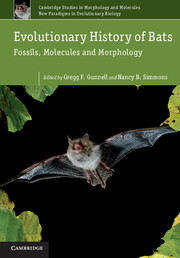Book contents
- Frontmatter
- Contents
- Contributors
- Preface
- 1 Phylogenies, fossils and functional genes: the evolution of echolocation in bats
- 2 Systematics and paleobiogeography of early bats
- 3 Shoulder joint and inner ear of Tachypteron franzeni, an emballonurid bat from the Middle Eocene of Messel
- 4 Evolutionary history of the Neotropical Chiroptera: the fossil record
- 5 New basal noctilionoid bats (Mammalia: Chiroptera) from the Oligocene of subtropical North America
- 6 Necromantis Weithofer, 1887, large carnivorous Middle and Late Eocene bats from the French Quercy Phosphorites: new data and unresolved relationships
- 7 African Vespertilionoidea (Chiroptera) and the antiquity of Myotinae
- 8 Evolutionary and ecological correlates of population genetic structure in bats
- 9 A bird? A plane? No, it's a bat: an introduction to the biomechanics of bat flight
- 10 Toward an integrative theory on the origin of bat flight
- 11 Molecular time scale of diversification of feeding strategy and morphology in New World Leaf-Nosed Bats (Phyllostomidae): a phylogenetic perspective
- 12 Why tribosphenic? On variation and constraint in developmental dynamics of chiropteran molars*
- 13 Necromantodonty, the primitive condition of lower molars among bats
- 14 Echolocation, evo-devo and the evolution of bat crania
- 15 Vertebral fusion in bats: phylogenetic patterns and functional relationships
- 16 Early evolution of body size in bats
- Index
- Plate section
- References
8 - Evolutionary and ecological correlates of population genetic structure in bats
Published online by Cambridge University Press: 05 June 2012
- Frontmatter
- Contents
- Contributors
- Preface
- 1 Phylogenies, fossils and functional genes: the evolution of echolocation in bats
- 2 Systematics and paleobiogeography of early bats
- 3 Shoulder joint and inner ear of Tachypteron franzeni, an emballonurid bat from the Middle Eocene of Messel
- 4 Evolutionary history of the Neotropical Chiroptera: the fossil record
- 5 New basal noctilionoid bats (Mammalia: Chiroptera) from the Oligocene of subtropical North America
- 6 Necromantis Weithofer, 1887, large carnivorous Middle and Late Eocene bats from the French Quercy Phosphorites: new data and unresolved relationships
- 7 African Vespertilionoidea (Chiroptera) and the antiquity of Myotinae
- 8 Evolutionary and ecological correlates of population genetic structure in bats
- 9 A bird? A plane? No, it's a bat: an introduction to the biomechanics of bat flight
- 10 Toward an integrative theory on the origin of bat flight
- 11 Molecular time scale of diversification of feeding strategy and morphology in New World Leaf-Nosed Bats (Phyllostomidae): a phylogenetic perspective
- 12 Why tribosphenic? On variation and constraint in developmental dynamics of chiropteran molars*
- 13 Necromantodonty, the primitive condition of lower molars among bats
- 14 Echolocation, evo-devo and the evolution of bat crania
- 15 Vertebral fusion in bats: phylogenetic patterns and functional relationships
- 16 Early evolution of body size in bats
- Index
- Plate section
- References
Summary
Introduction
Studies of intraspecific genetic structure are of central importance to evolutionary biology, as population differentiation can lead to distinct evolutionary trajectories and may be viewed as the first step in the process of speciation (Wright, 1932). The distribution of genetic variation among populations is determined by a complex interaction of historical and contemporary evolutionary forces – including genetic drift, mutation, selection and gene flow – which are influenced by the specific life history, behavior and ecology of a species (Slatkin, 1987; Goodnight, 2006). Historical events such as vicariance, colonization events or glacial refugia can also dramatically shape contemporary patterns of genetic subdivision. Gene flow is the primary force that leads to genetic homogeneity among populations, and species may be subject to geographic, behavioral or ecological barriers to gene flow. The task of teasing out the relative importance of different life-history, behavioral and ecological characteristics in determining genetic structure, each taking place across a range of temporal and spatial scales, continues to challenge population geneticists (Hey and Machado, 2003; Estoup et al., 2004; Duminil et al., 2007).
Bats (order Chiroptera) which comprise nearly 1200 species, exhibit a wide range of life-history and ecological characteristics that make them an ideal group to test hypotheses regarding the correlates of population structure in animals (Nowak, 1999; Simmons, 2005). Being nocturnal and difficult to study by traditional ecological methods (including direct observation, telemetry and capture–mark–recapture), a growing number of studies have used molecular markers to examine the population biology of bats (Burland and Worthington-Wilmer, 2001). In general, population genetic studies of volant animals are of particular interest because of their potential for long-distance dispersal and high levels of gene flow over terrestrial and oceanic landscapes.
- Type
- Chapter
- Information
- Evolutionary History of BatsFossils, Molecules and Morphology, pp. 267 - 316Publisher: Cambridge University PressPrint publication year: 2012
References
- 6
- Cited by



